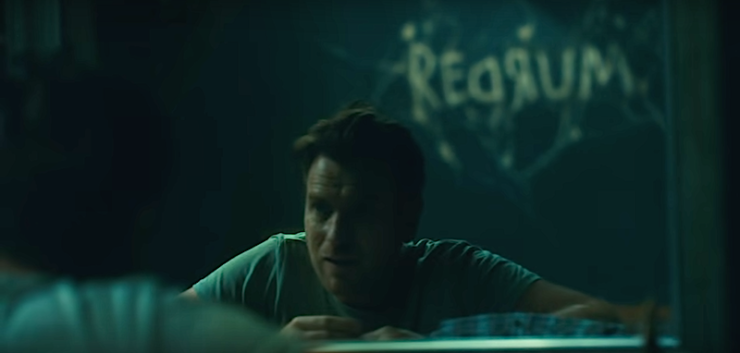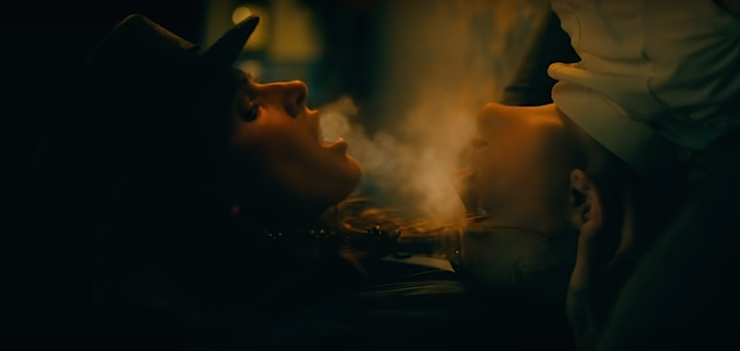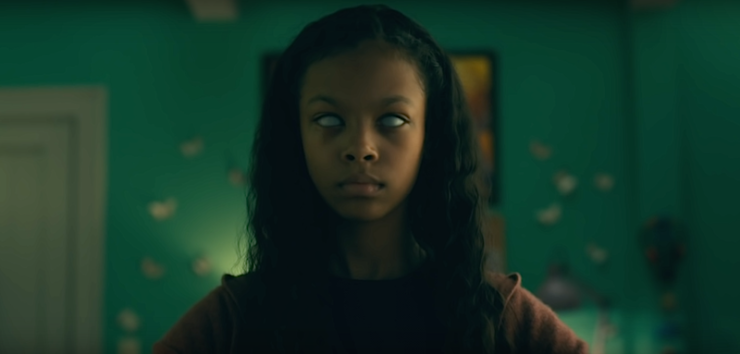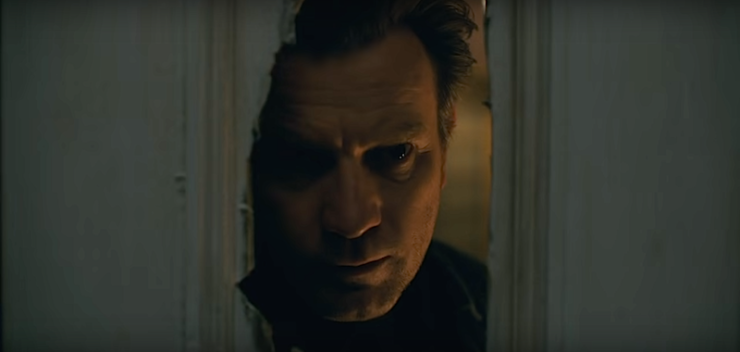I am of two minds.
On the one hand, this may be the best possible sequel to The Shining. Mike Flanagan has managed to synthesize the most iconic parts of Stanley Kubrick’s film, with the deep love that Stephen King had for his characters—the love that was so strong he had to catch up with Danny Torrance nearly forty years later in a 2013 sequel. Flanagan wrangles Doctor Sleep’s original characters and puts them in conversation with Kubrick’s visuals and the sense of haunted despair that make The Shining such an unsettling watch.
But on the other hand, this is a fundamentally different film than the Shining. It does some things with tone and intention that undercut Kubrick’s vision. And despite the ghosts and mystical trappings, Doctor Sleep is not a horror movie.
Doctor Sleep boldly starts immediately after the events of Kubrick’s The Shining, with Danny and Wendy holed up in a hotel in Florida, trying to recover. This is complicated by some of the ghosts from the Overlook, who seem to have attached themselves to Danny and haunt him specifically. When we cut to adult Dan, he’s pickling himself in whiskey, doing his best to suppress the Shining by staying drunk or hungover as much as possible. (His Rock Bottom is terrifying, and really looks more like a deleted scene from Trainspotting than anything else.) He cleans up, tries, again, to heal, and forges a psychic connection with Abra, a child who also Shines. Intercut with his story of healing is the tale of Rose the Hat and the acolytes of the True Knot, who feed on a substance they call “steam”—the psychic energy released by children with the Shine. Unfortunately, kids release a lot more steam if they’re terrified and/or in pain, which means that the True Knot have been kidnapping kids to feed on. When Abra is targeted by Rose the Hat, Danny has to tap into his full Shine to try to save her…which means returning to the Overlook.
The acting is uniformly superb. Ewan McGregor plays Dan as walking wounded, clearly shocked to find himself still alive no matter how much he hopes to drink himself to death. As he begins to recover he invests the character with so much warmth that he made me want to go back and read the book just so I can spend more time with him. Kyliegh Curran is fantastic as Abra Stone, tough and brave, but also believably a kid who gets scared and overwhelmed. (She’s also believably ready to hurt the bad guys when they come after her, without any of the moral ambivalence that an older person might have.) But maybe best of all is Rebecca Ferguson as Rose the Hat, who is genuinely chilling, but also super hot? So, my type basically?
Really, beyond telling you that if you love King and Kubrick you’ll find a lot to like in this movie, I don’t have much else to say without getting into spoilers. Doctor Sleep is probably a bit too long, but that’s going to happen when you’re adapting a 531-page novel, and honestly I didn’t notice the length during the film. I think Flanagan’s trying to do something interesting here, and I hope people go see it.
Now, I do have a lot of very spoilery things to say about the film’s themes, so if you want to join me for that, read on!

Stephen King famously hates Kubrick’s film of The Shining. (If you want to laugh a whole bunch, go read Grady Hendrix’s review of Doctor Sleep where he riffs on that hatred.) But the reason he hates it is fascinating to me. Supposedly, following a screening of the movie, King was quoted as saying: “I think [Kubrick] set out to make a film that hurts people.”
Which, yes, yes that’s exactly what Kubrick did. Everything about The Shining, from the panoramas, to the incredibly unsettling, unresolved music, to the fact that the hotel doesn’t make any sense spatially, to the incredibly intense aura of domestic violence that hangs over the whole film, to the fact that Jack Nicholson plays Torrance as unhinged and Shelley Duvall plays Wendy as just barely keeping it together from moment one, all adds up to a film that, if you don’t mind me dipping into technical film critic jargon, makes you feel bad.
Some people, like me, are cool with that—I think The Shining commits to being a horror film and I admire it. Doctor Sleep, however, only gives us true horror in a few scenes, preferring to focus much more on questions of trauma and whether recovery from trauma is even possible. And in the background of that serious, heavy discussion, what the film really seems to want to talk about is different attitudes toward death.
Can Dan recover from alcoholism? From his trauma? Once he gets to the Overlook it seems like no. His fury at his father and his need for alcohol come roaring back. He battles his own demons and the demons of the Overlook but that battle is muted—compared with the visceral scenes of Dan hitting rock bottom, the scenes of him fighting the ghosts who have haunted his entire life felt strangely distant to me. I wanted more of a sense that the Overlook is trying, at least at first, to seduce him, as it seduced his father with naked women and fancy Gold Ballroom parties before tightening its grip. The scenes of Dan “waking” the Overlook are much more atmospheric and frightening than seeing him swarmed by the Grady girls and the Bathtub Lady.
It’s strongly implied, though, that Abra is going to be OK—which makes no sense. Her father has been murdered because of her ability. Her mother spent days thinking Abra had been kidnapped, and is now dealing with that trauma as well as the loss of her husband, on top of trying to handle the death of her own mother back in California. Any one of those things would require a lot of therapy to work through, but this poor woman seems to be back to making dinner for her kid, in the house where she found the corpse of her husband, within a few weeks of the whole experience. The Overlook ghosts have now attached to Abra, presumably, as at least one shows up in the house, 2,000 miles from its usual haunting spot. Abra is now talking with Ghost Dan as Dan talked with Ghost Hallorann.
And yet the film frames Abra and her mom as solid, strong, and fundamentally OK. This is where I think it needed to take more of a cue from Kubrick, rather than King. While I get wanting the characters you love to heal and move on, I also think that Doctor Sleep needed to send us out of the theater with more of an undercurrent of trauma. We need to feel that there have been some emotional consequences here.
Now, a few words about death.
It’s only natural that a horror movie (even one that doesn’t spend much time being horror) would need to dig into death. Most classic horror films either show a lot of people being killed in various ways, or explore the aftermath of death through ghosts, vampires, zombies, etc. But Doctor Sleep take a much more methodical approach, looking at different ways living people can approach mortality.
The Overlook is built on an Indian Burial Ground. The deaths of the Indigenous people, and their resting place, have been desecrated by capitalism and greed, which is why one of the many readings of the movie is that Kubrick layered in subtext about white colonists’ murder and oppression of Indigenous Americans. That’s one layer, where a Good Death has been uprooted.
In the next layer, we learn that the Overlook has trapped an unknown number of dead souls in the hotel. The hotel is animated by them, feeds on them, and uses them as predators to trap new people like Jack Torrance. How much the hotel itself is sentient and malevolent is unknown. If there is a head spirit, or an Unmoved Mover, we never meet them. (We also know that Dick Hallorann is able to live at the Overlook. We learn a little bit more about how and why in Doctor Sleep.) We also learn that some of the ghosts can attach to people and follow them. At least, they can attach to people with Shine.

In the next layer, we learn that Rose the Hat and the others are trying to fight death, trying to duck it by feeding off the Shine of others. They kill people and eat their steam, which is maybe part of their soul? They don’t really define what steam is, or whether there’s a part of a person’s personality in it, or what happens when a True Knot dies and releases their steam. When Rose opens the steam canisters there is a faint screaming to be heard, which implies to me that part of the victim is still in there. (This actually reminded me a lot of a fairly pulpy film from the 1980s called The Serpent and the Rainbow, in which people’s souls are trapped in little jars, but when the jars are broken, the souls are able to escape, fully-formed.) So how does it work in this universe? Given that the True Knot will breath in steam and then breathe it into another member’s mouth, is it getting diluted? When the last True Knot member dies, will all the steam escape and reform into individual people?
The fourth layer involves Danny himself. He’s called “Doctor Sleep” because he helps people die. After he’s gotten sober he’s offered a job in a hospice center, and when his new boss asks if he’s OK being around dying people, his reply is “Well, we’re all dying,” which is hilarious when you know Dan Torrance’s particular history. I’d imagine the guy who lived in the Overlook wouldn’t be too bothered by dead people, as long as they’re not trying to choke him to death or suggesting he try on a bear suit. We get the sense that after a lifetime of wandering and dulling his pain with liquor, Dan has finally found a good life. He works the night shift (presumably because other people find it creepy) and whenever the center’s cat, Azzie, goes into a terminal patient’s room, Dan follows and sits with them. He’s able to use his Shine to connect with them and ease their fear of the unknown, because having spent his life running from ghosts, he’s now able to accept death as just another part of life, and offer the comfort no one was able to give him when he was a child.
In Kubrick’s take on The Shining, Jack only ever talks to ghosts when there are mirrors in the room. This lends credence to the interpretation that there are no actual ghosts in the Overlook—Jack is the only monster. (I personally don’t agree with this idea, and obviously Doctor Sleep refutes it, but I love that Kubrick seeded the possibility.) The sequel also uses mirrors, but in a far more metaphorical way, mirroring entire scenes that draw the film’s themes out. One of them is genuinely one of the most horrific things I’ve ever seen. Rose and the True Knot kidnap and torture a child for his steam. Now I don’t disturb easy, and I hate the trope of putting a kid in danger to wring easy emotion out of an audience. However, in this instance I think it works. Flanagan frames the scene very carefully. We don’t really see exactly what Rose is doing to the child, because the camera stays on his face, documenting his steam as it escapes, and making his pain and fear the point of the scene. This is awful. But we also see exactly how monstrous this act is, and we experience the child’s death as his death—not, as in some of the other scenes, an overhead shot of vampires swarming on a victim, And while we do get the requisite “older vampire looks healthier once he’s eaten” moment, the camera keeps bringing us back either to the victim, or to Abra, who creates a psychic link to him and witnesses the murder. We’re never given the opportunity to find the vampires hot, or feel some sort of glee because Hannibal killed someone obnoxious, or see the dark humor in zombies decimating a mall. This is a murder, and it’s terrible.
This scene is mirrored in a scene of the True Knot’s elder dying. Rose sits with him and consoles him by reciting his past to him—like all good vampires he terrorized villages and left a trail of myths behind him. But in the end, the story can’t stop his death, and he seizes and screams and dissolves into steam, which is promptly inhaled by the rest of the Knot, who set upon his deathbed like vultures.
Finally, these scenes are both mirrored by Dan’s bedside vigils, as he sits and tells dying people the stories of their lives. When he’s with the dying he can finally stop suppressing his Shine; instead it helps him see people’s pasts, and find the details that will give them the most comfort. It also allows him to see their steam escaping as they die. Rather than trying to cling to life, he’s willing to be still and witness it as it changes.

This is the heart of the film for me, far more than the final showdown at the Overlook, or any of Abra’s (admittedly awesome) battles with Rose, or even the bond between Abra and Dan. Instead of just making a horror movie filled with homages to Kubrick, or preoccupied with restoring King’s vision of The Shining, Flanagan has given us two opposing ways to approach death. He’s given us two extremely compelling characters in Rose and Dan, allows them to be equally seductive, and actually takes the time to let their argument play out. They metaphysically stand against each other, and the rest of the film ricochets between the two of them.
The result isn’t exactly a horror movie, but Doctor Sleep becomes something with a lot more depth and meaning than I ever expected.
Leah Schnelbach hopes that their eventual hospice center has a cat like Azzie, cause then they’ll be too busy saying “KITTY!” to ever die. Immortality unlocked. Come Shine at them on Twitter!










